
How to Solve Common Vegetable Garden Problems
By Chris Edmunds
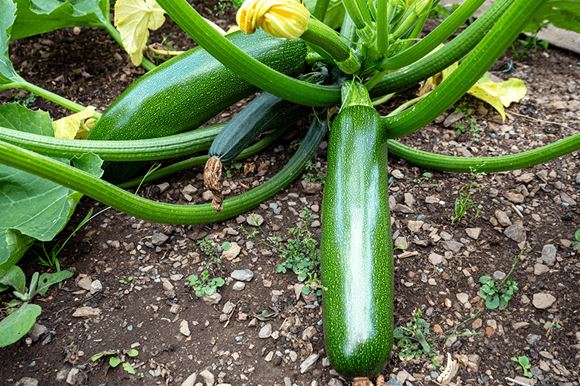
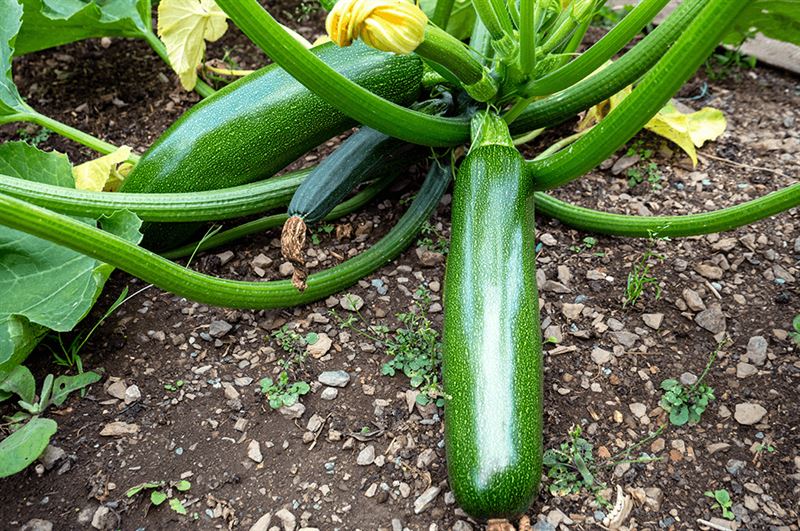
Growing your own veggies can make life a whole lot brighter, but there are some common vegetable problems that can throw a wrench in your plans. Luckily, it’s a challenge we’re well equipped to solve, and soon you will be too! Take a glance at this quick crash course on how to solve vegetable garden problems, so you can identify the culprits and get them out fast!
Tomato and cucumber plant problems seem to be giving gardeners the most grief, so we first focused on those two areas and saved all our other general vegetable garden problems for the end. Don’t be intimidated by the list—all these problems have simple solutions, and if you have the right products and tools on hand, you can beat them no problem!
Tomato Plant Problems
Tomatoes are easily one of the most popular edible plants to grow in a vegetable garden because of their high crop yield. And with so many colorful varieties with different fruit sizes and flavor profiles, it’s hard to resist planting an assortment. However, they tend to be susceptible to a number of plant diseases, so it’s important to keep an eye out for the signs.
These are some of the more common problems to spring up in your tomato patch, and how to easily beat them:
Early Blight on Tomato Plants occurs right after your plant has produced its first few fruits. Leaves will develop spots in the early stages, which then turn into rings with dead plant tissue in the center. The fruit will not be harmed, but the plant will still suffer from leaf loss. Remove all affected plant material with clean shears and throw it in the garbage or burn it. Like with any plant disease removal, sanitize your shears with alcohol after each cut. Follow up with a treatment of copper fungicide to kill the remaining spores. It’s important to get rid of all traces because these spores can live in the ground over winter and pop up again next spring. Crop rotation will help lessen your chances of it coming back again and again.
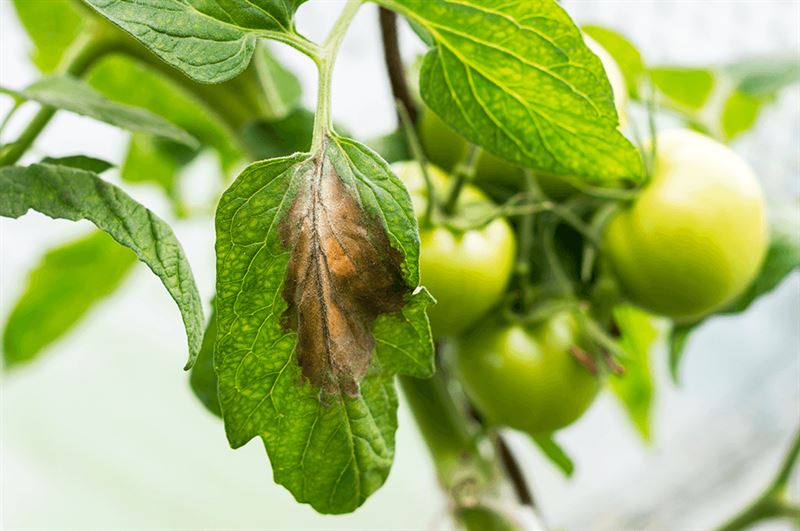 Late Blight on Tomato Plants starts as dark, damaged plant tissue, and when left untreated, it can harm the fruits. Big brown or black spots on your tomatoes are a sign of severe late blight. It spreads very quickly if conditions are humid. Cut out all the affected pieces with sanitized shears, just like you would with early blight, and follow up with a copper-based fungicide. Late blight on tomato plants can pop up at any time in the growing season, but thankfully, this disease doesn’t hibernate over the winter like early blight.
Late Blight on Tomato Plants starts as dark, damaged plant tissue, and when left untreated, it can harm the fruits. Big brown or black spots on your tomatoes are a sign of severe late blight. It spreads very quickly if conditions are humid. Cut out all the affected pieces with sanitized shears, just like you would with early blight, and follow up with a copper-based fungicide. Late blight on tomato plants can pop up at any time in the growing season, but thankfully, this disease doesn’t hibernate over the winter like early blight.
Tomato Plant Leaves Turning Black is a sign of septoria leaf spot—one of the trickiest tomato plant diseases. Like early blight, it can overwinter in your yard and then pop up seemingly out of nowhere at the start of the gardening season. It causes little black spots all over the leaves, eventually causing them to turn yellow, then brown, and then fall off. Trim damaged pieces off with sanitized shears, using an alcohol wipe between each cut, and throw out or burn all the diseased cuttings. Follow up with some copper fungicide.
Blossom End Rot is actually a sign of calcium deficiency in tomato plants. The tip of each tomato fruit (where their blossom once was) will rot and turn brown. To prevent blossom end rot, you should use fresh soil with a balanced pH, with plenty of fertilizer and micronutrients. Watering regularly will also help to avoid calcium deficiency. If your plant is showing signs of blossom end rot, the tomatoes already affected can’t be saved (though they can still be eaten if you cut the brown ends off). To prevent any more tomatoes from developing blossom end rot, you can spray a calcium solution on your tomatoes while they’re young.
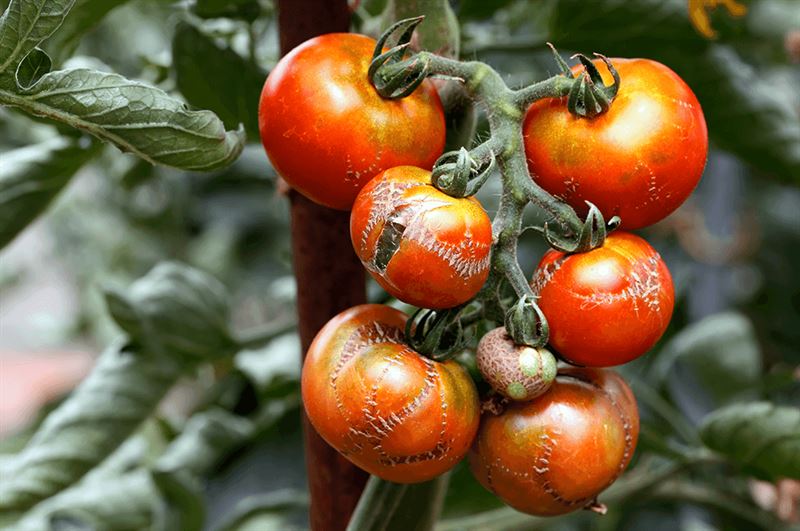 Cracked Tomato Skins are caused by insufficient and irregular watering. Water your tomatoes regularly and generously, and make sure the soil has good drainage to prevent root rot.
Cracked Tomato Skins are caused by insufficient and irregular watering. Water your tomatoes regularly and generously, and make sure the soil has good drainage to prevent root rot.
Tomato Plant Yellowing Leaves are a common sight in the garden because there are a few things that can cause it. Stress from overwatering or underwatering can cause yellow leaves, so it’s important to maintain a consistent schedule. Nitrogen deficiency can also be the cause, so it’s worth performing a soil test to see if anything is amiss. Lack of sun can cause yellow leaves on the bottom of the plant, so make sure this heat-loving vegetable is getting plenty of sunshine.
Cucumber Plant Problems
The satisfying crunch of a fresh cucumber (or a tangy homemade pickle) is well worth the effort of growing on your own. These vining veggies aren’t too difficult to grow, but there are a few issues you should keep an eye out for:
Cucumber Beetles are little yellow bugs with black stripes or spots. They tend to go after all cucurbit plants, like squash, pumpkins, and melons. Yellowing leaves and visible bite holes are telltale signs that you’ve got a beetle problem. To get rid of them, we recommend starting by shaking the plant over a garbage bag to knock off some of the beetles into the bag. Tie it up and throw it in the trash! Then, follow up with a natural pesticide that’s safe for outdoor use, like neem oil or insecticidal soap spray.
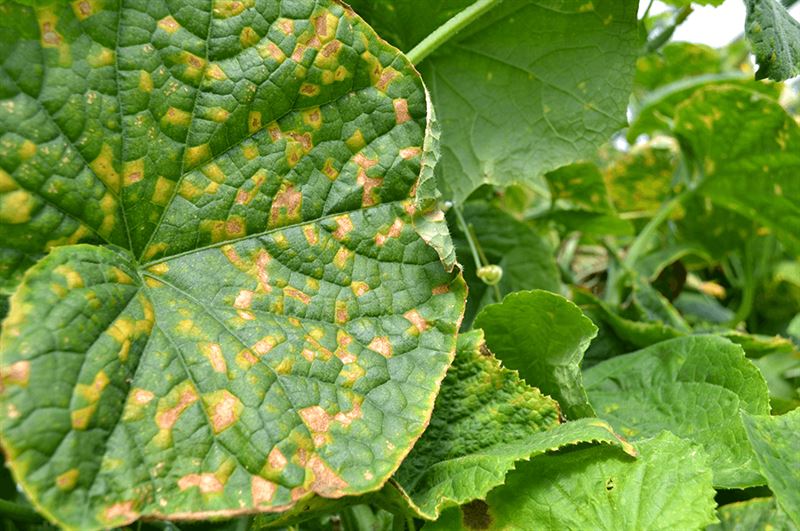 Angular Leaf Spot looks like yellow or beige spots that are moist and stay within the confines of the leaf veins, causing an angular appearance. It tends to pop up in all cucurbits, but most often, cucumbers. Watering your plants overhead can increase the risk of angular leaf spot, so it’s a good idea to water the soil directly instead. Do the usual drill for disease removal: cut out affected parts with sanitized shears, safely dispose of all affected material, and follow up with a copper fungicide.
Angular Leaf Spot looks like yellow or beige spots that are moist and stay within the confines of the leaf veins, causing an angular appearance. It tends to pop up in all cucurbits, but most often, cucumbers. Watering your plants overhead can increase the risk of angular leaf spot, so it’s a good idea to water the soil directly instead. Do the usual drill for disease removal: cut out affected parts with sanitized shears, safely dispose of all affected material, and follow up with a copper fungicide.
Powdery Mildew is a common vegetable garden problem but loves to pop up on your cucumber plants. It looks like a fine white powder coating the leaves, but luckily it isn’t as harmful as other diseases. Like with other garden pathogens, you should remove diseased parts and apply a fungicide afterward, but prevention is especially important for keeping powdery mildew at bay. It’s caused by moisture buildup and lack of air circulation, so you should never water your plants overhead—water at the soil level. It also helps to prune your plants a bit, so the foliage isn’t too dense.
Moisture Stress can cause your cucumbers to form wonky shapes, with puckered parts and deformations. Since their root system is so shallow, if water is evaporating from your garden quickly due to hot sunlight, you may need to water every day. Keep your watering schedule as consistent as possible to avoid moisture stress issues.
Other Vegetable Garden Problems
Here are some other vegetable garden problems you might face this year and how you can tackle them like a total pro.
 Hungry Rabbits and Deer are the banes of any gardener’s existence, as they are eager to eat up all our hard-earned crops. You can use cages and wire fencing to keep them away, but you must bury them deep in the ground so rabbits can’t burrow underneath. Blood meal or bone meal formulas are also safe to use on vegetable plants as a pest repellent. We can’t detect the smell, but it tips off rabbits and deer, so they think a predator is nearby with a fresh kill. This effectively scares them off, but it needs to be reapplied after heavy rainfalls.
Hungry Rabbits and Deer are the banes of any gardener’s existence, as they are eager to eat up all our hard-earned crops. You can use cages and wire fencing to keep them away, but you must bury them deep in the ground so rabbits can’t burrow underneath. Blood meal or bone meal formulas are also safe to use on vegetable plants as a pest repellent. We can’t detect the smell, but it tips off rabbits and deer, so they think a predator is nearby with a fresh kill. This effectively scares them off, but it needs to be reapplied after heavy rainfalls.
Stumpy Carrots are always a disappointment to pull from the ground. It’s caused by compacted soil as the carrot can’t properly penetrate through. Prevent this by making sure your soil is nice and loose. It’s easier to control soil compaction in a raised garden bed, so if the soil in your yard is a bit too tough to dig up, try building your own DIY raised bed for better results!
Bolting occurs when your vegetable or herb plant sprouts flowers instead of developing the tasty leafy greens or hearty roots we grow them for. This is often because the plant has been exposed to too much sun and heat. Cool-weather crops like radishes, cilantro, lettuce, and beets can bolt, so it’s a better idea to plant them in early spring or late summer when temperatures are less intense.
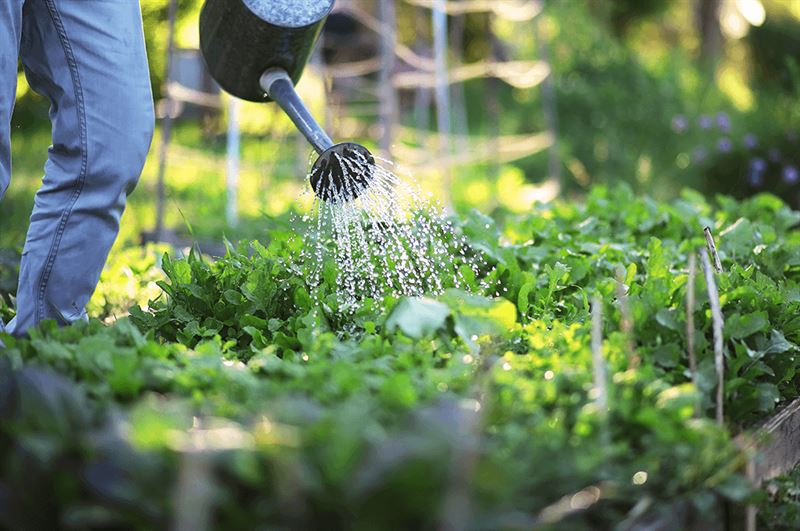 Why is my Vegetable Garden Not Producing?
Why is my Vegetable Garden Not Producing?
If your vegetable garden is a flat-out flop, there may have been some missteps along the way. Here are a few reasons your vegetable garden isn’t the resounding success it ought to be:
-
Overcrowding your plants
-
Over-fertilizing seedlings
-
Too little or too much water at the seedling stage
-
Soil lacking nutrients
-
Insufficient sun
-
No pollination
-
Incompatible plants planted together
To set your garden up for success, don’t just dive right in—go in with a plan. Here are some steps you should follow:
-
Draw up a layout and check how much space each of your plants needs to thrive.
-
Do a Google search of plant compatibility and make sure you aren’t making neighbors out of two vegetables that don’t get along.
-
Pay attention to the natural light levels in your yard, and plant your vegetables where they’ll be happiest.
-
Avoid using chemical pesticides that hurt pollinators like bees and butterflies because we depend on them for our garden to succeed.
-
Follow the directions on the back of your seed packs closely.
-
Maintain a consistent watering schedule.
-
Mix plenty of fresh compost into the soil at the start of the season to load it up with nutrients and healthy bacteria.
Any other vegetable garden problems you need help tackling? Don’t hesitate to contact our garden center—our experts will be happy to assist! And if you’re on the lookout for vegetable plants for sale near you, we have an incredible collection of seeds and starter plants for spring 2021. Hurry down to get first dibs on the biggest, brightest, tastiest vegetable garden plants for your own backyard produce aisle.

